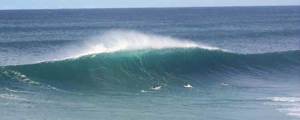jackson pollock and washaway sand dunes

Those times when a month of outrageous seas from the east cuts away twenty years of dune accumulation on the beach; all the tussock grass roots trailing away into the salt air, casuarinas uprooted and toppled, cliffs of sand sometimes over ten foot high and impossible to climb.
Bodies buried in garbage bags slowly extruded from the depths they were buried in twenty years ago, rusty knives, sawn off shotguns, and cliffs of sand with their impossible ledges and constant sand falls. Like the Himalayas, in miniature.
El Capitan, Half Dome, the Eiger, the Ogre, all there.
You only have to look.
Closely.
Old fellow over there on his hands and knees urging on a massive avalanche. The closer he looks at these loose sand walls the more they look the same, the perception remains.
Jackson Pollock knew this, must have.
A century ago somebody bought one of his Impasto based paintings for over a million aud because they saw something in his mess that was unfigurable to anybody who was unable to drink as much as Jackson did while he created it. He called it number 11, we call it Blue Poles. It still hangs somewhere in this country, some gallery, and his perception of things still remains a mystery. Nice colours though.
What you might do with number 11 is ask the curator, or the body at the front door who takes your money for a small square of wood, or plastic, like a picture frame without a picture in it. Just a small empty square.
This is how Pollock’s perception might be better understood, as if it matters because his stuff goes for more than millions now. Still, a print might be good value. You can do this in the kitchen at home.
Put yourself in the gallery so you can see all of the painting, the whole beast, then walk up real close and put the empty square frame anywhere on the painting and ask the lad by the lights to illuminate just that place, the small part of the massive work that is enclosed in your $2 plastic frame.
– and it’s the whole painting in miniature. Same densities, same colour compositions, same spatial dimensions, same confounding intelligence it took to create the work in its entirety and now here it is in its detail.
This framing exercise is endless, like cutting something in half, and half again, and again … and again and again … because there will never be a time when half of something is nothing.
Eternity. Arthur Stace. Chalk on a city street. Stace and Pollack, sounds like a musical. Those lads knew the tune, God sings all the languages.
Pollock must have had the eyes of a house fly to see the same thing close up as from a distance. Or the sight of an eagle drifting this way and that three miles high in the moving air with its fixed and magnified small square of killing vision centred on just the two square feet of paddock so far below, and the rabbit lunching there.






JP got his inspiration for that from my own No. 9 masterpiece, also known as “Laminating shop floor as seen on acid”. Where’s my money?
in the mail …
Reckon the most exhausting kind of art must be that whose methodology is based purely on beautiful accidents…